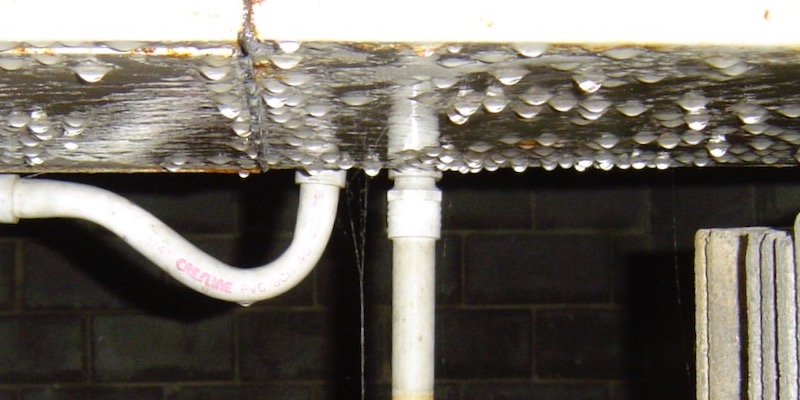3 Important Facts About Dew Point Temperature

That photo above is the bottom side an air conditioner in a crawl space on Hilton Head Island, South Carolina. Those droplets tell us something important: A property of the air in that crawl space aligned with a property of that surface to convert water vapor into liquid water. What are those two properties? And what else should we know about dew point? Let’s do a quick check on some important facts about dew point temperature and find out.
1. The dew point is a temperature
I’ve certainly been guilty of using the shorthand term “dew point” and will continue to do so. It’s important to remember, though, that whenever we talk about dew point, we’re talking about a temperature. It’s not a place or time or event. It’s a temperature. And the dew point temperature tells us when condensation like you see above will happen. It tells us about the potential for condensation but not the actual occurrence.
2. The dew point temperature is a property of the air
More correctly, the dew point temperature is a property only of the water vapor in the air. But we’re here on Earth. Our atmosphere and buildings are filled with both the dry air components (nitrogen, oxygen…) and water vapor, so it’s OK to say the dew point temperature is a property of the air. And that property is related to the concentration of water vapor in the air. The more water vapor per volume of air, the higher the dew point temperature will be. (The dew point temperature is also related to pressure.)
3. Materials have a temperature, but not a dew point
Dew point temperature is a property of a material in the vapor phase. That metal air conditioner in the photo is definitely not a vapor. It’s a solid material. It has a temperature. But it doesn’t have a dew point temperature unless you vaporize it.
Avoiding dew point confusion
The point I’m trying to make here is that condensation is the result of two separate properties being aligned: the dew point temperature of the air and the surface temperature of a material in contact with the air. The air has its dew point temperature. When a nearby surface has a temperature at or below the dew point temperature, condensation occurs. They’re two separate things.
There are other important facts about dew point temperature, too. In this article, my focus is on condensation only. That’s what you see in the photo above, on a window when it’s cold outdoors, or on the bathroom mirror after your shower. Water vapor interacts differently with porous materials like drywall and wood, though. I’ve got things to say about that topic, too, but we’ll save it for another time. Meanwhile, if you want more, you can ponder whether it’s possible to get condensation on a sponge.
Allison A. Bailes III, PhD is a speaker, writer, building science consultant, and the founder of Energy Vanguard in Decatur, Georgia. He has a doctorate in physics and writes the Energy Vanguard Blog. He is also writing a book on building science. You can follow him on Twitter at @EnergyVanguard.
Related Articles
Make Dew Point Your Friend for Humidity
Bad Advice About Indoor Humidity in Cold Weather
Accidental Dehumidification – A Preventable Mess
NOTE: Comments are moderated. Your comment will not appear below until approved.
This Post Has 5 Comments
Comments are closed.

And that condensation on the surface shown in the picture is inspite of the affect of the sensible heat from the surrounding surfaces/materials in the crawlspace to change the dewpoint of the surface of the duct in the crawlspace.
Nice succinct explanation, Allison.
i have a similar problem in my passive ventilated attic in florida in summer, what’s your recommended remedy?
@steven, I’m assuming by ‘similar problem’ you mean condensation on ducts. The two most likely causes for that are low airflow and problems with the supply-side duct insulation, especially for locations close to the air handler where supply air is coldest.
Insulation problems are common, including exposed bare metal and/or insulation jacket poorly sealed.
Inadequate airflow (relative to A/C capacity) is also a very common problem. This causes the supply air to be too cold, which contrary to what one might expect, actually *reduces* an air conditioner’s ability to cool the air. Low airflow can be caused by any or all of the following conditions: (a) improper blower speed setting, (b) inadequately sized ducts (i.e., too small), (c) as a crushed or pinched duct, and/or (d) the filter is dirty or overly restrictive.
Most of these problems can be diagnosed and remedied by a smart HVAC technician. I recommend looking for “NATE certification” when selecting a mechanical contractor to diagnose airside problems.
Steven: In addition to what David said, duct leakage in the supply ducts can cause condensation problems. When cold air leaks into the duct insulation, it can lower the surface temperature of the outer jacket, which can lead to condensation. Duct sealing is the solution. Another issue that causes condensation is when two ducts are rubbing up against each other. Separating the ducts is the solution. And burying ducts in attic insulation in Florida can lead to condensation. Here’s what I wrote about that:
Buried Ducts Risk Condensation in Humid Climates